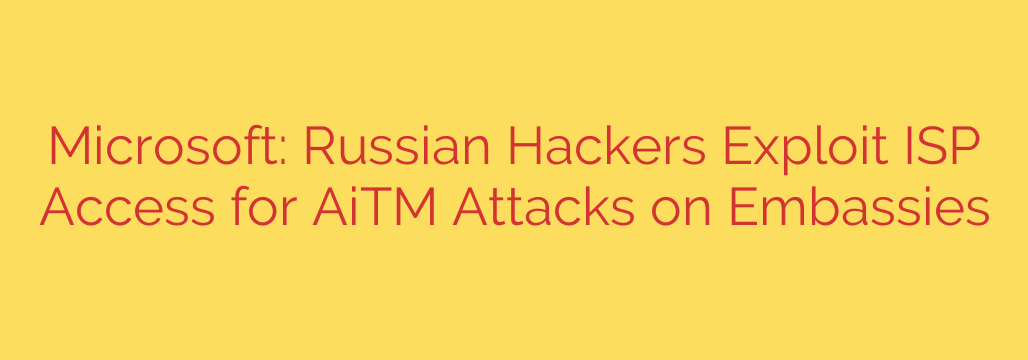
Russian State-Sponsored Hackers Exploit Home Routers for Advanced Cyber Espionage
In a significant escalation of cyber espionage tactics, a sophisticated Russian state-sponsored hacking group is targeting Western diplomatic missions by exploiting a critical vulnerability in residential internet infrastructure. The group, known as Midnight Blizzard (also identified as APT29 or Nobelium), has found a novel way to launch highly deceptive attacks that can bypass even robust security measures like Multi-Factor Authentication (MFA).
This campaign leverages compromised network devices, such as home and small office routers, to stage attacks that appear to originate from legitimate local IP addresses. By hijacking these devices, the attackers can effectively spy on government, diplomatic, and NGO targets, gaining persistent access to sensitive cloud-based information.
The New Threat: AiTM Attacks from Your Neighbor’s Network
The core of this operation involves a technique called an Adversary-in-the-Middle (AiTM) attack. Unlike traditional phishing where hackers simply steal a password, an AiTM attack goes a step further by hijacking a user’s entire authenticated session.
Here’s how it works:
- The Lure: The attack begins with a carefully crafted phishing email, often disguised as a technical support notification, sent to a high-value target within a diplomatic or government organization.
- The Hijack: When the victim clicks the link, they are directed to a fake Microsoft 365 login page. However, this isn’t just a static copy. The page acts as a proxy, sitting between the victim and the real Microsoft service.
- The Theft: The victim enters their username, password, and even their MFA code. Because the hackers are in the middle of the communication, they are able to intercept the session cookie generated after the successful MFA authentication.
- The Breach: With this stolen session cookie, the attacker can now access the victim’s Microsoft 365 account—including Outlook emails, SharePoint files, and Teams chats—without needing the password or MFA device. The security check has already been passed.
What makes this campaign particularly insidious is the use of compromised residential routers. The attackers have been observed exploiting Ubiquiti EdgeRouters located in residential networks. By controlling these devices, they can route their malicious traffic through them, making the AiTM attack appear to come from a legitimate, trusted residential IP address. This makes detection and blocking extremely difficult for security teams.
Who is Midnight Blizzard?
Midnight Blizzard is a highly skilled and persistent threat actor attributed to Russia’s Foreign Intelligence Service (SVR). This is the same group responsible for other major cyber attacks, including the infamous SolarWinds supply chain compromise. Their primary objective is intelligence gathering, and they consistently target government, diplomatic, non-governmental organization (NGO), and IT service provider sectors.
Their ability to innovate and adapt their methods, such as using compromised network hardware as a covert operational platform, marks them as one of the most dangerous state-sponsored threats currently active.
Why This Matters for All Organizations
While the current targets are focused on diplomatic missions, the techniques used by Midnight Blizzard are a serious warning for all organizations. The methods pioneered by state-sponsored groups often trickle down and are adopted by other cybercriminals.
The key takeaway is that conventional MFA methods are no longer foolproof. If your organization relies on MFA delivered via SMS, push notifications, or one-time passcodes, you are vulnerable to AiTM attacks. The exploitation of common routers also highlights a frequently overlooked security gap in many work-from-home and small office environments.
Actionable Security Measures to Protect Your Organization
Defending against such sophisticated threats requires a layered, proactive security posture. Organizations, especially those using Microsoft 365, should take immediate steps to harden their defenses.
- Implement Phishing-Resistant MFA: Move beyond basic MFA. Transition to stronger, phishing-resistant authentication methods like FIDO2 security keys, Windows Hello for Business, or certificate-based authentication. These methods cryptographically bind the login process to a specific device, making it impossible for a session to be hijacked on an attacker’s machine.
- Strengthen Conditional Access Policies: Configure Microsoft 365 Conditional Access policies to enforce stricter controls. This includes blocking access from non-compliant devices, untrusted IP locations, and flagging impossible travel scenarios or anomalous sign-in behavior.
- Secure All Network Hardware: The compromise of routers is a critical lesson. Ensure all network devices (routers, firewalls, switches) have their default administrator passwords changed. Regularly check for and apply firmware updates to patch known vulnerabilities.
- Continuous Monitoring and Detection: Actively monitor sign-in logs and network traffic for suspicious activity. Look for sign-ins with mismatched properties (e.g., an IP address from one country but a device timestamp from another) or logins from unexpected residential IP ranges.
- Enhance User Training: Continue to educate users on the dangers of phishing, emphasizing that they should never click links from unsolicited emails and should always verify the authenticity of login pages before entering credentials.
The tactics employed by Midnight Blizzard represent a clear evolution in cyber espionage. By understanding their methods and implementing robust, modern security controls, organizations can build a more resilient defense against these advanced and persistent threats.
Source: https://www.bleepingcomputer.com/news/security/microsoft-russian-hackers-use-isp-access-to-hack-embassies-in-aitm-attacks/








